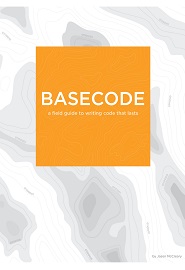
English | 2021 | 118 Pages | PDF, EPUB, MOBI, MP4, MP3, CODE | 1.25 GB
A field guide containing real-world practices to help you write code that’s less complex and more readable.
I’ve been writing code for 20 years.
During that time I’ve worked on hundreds of projects with dozens of teams. I found the most important quality of lasting code is readability.
When I first started writing code I just wrote code that worked. Who cares as long as it works? Years later, I went to great lengths to ensure my code adhered to all the best practices.
We know our code is too complex. This is easy to realize, but hard to avoid. We’re too quick to dismiss qualities like readability and accept complexity as necessary..
We need to get back to the basics of writing code for other humans. This is the goal of BaseCode.
It’s a field guide, not a book.
BaseCode distills writing readable code into 10 practices and contains over 40 code samples.
These practices focus on:
- Writing code that prioritizes readability by humans, not a computer
- Avoiding code rot with analysis and automation
- Untangling nested code to improve visual honesty and reduce reader overhead
- Introducing objects to encapsulate complexity
- Refactoring long blocks of code by understanding reading levels
- Making naming things easy with context and time
- Using code as the primary signal, not comments
- Avoiding unnecessary code by using reasonable return values
- Delaying the need to remove duplication with the Rule of Three
- Improving code flow with symmetry
- Deferring design decisions to reduce anxiety when writing code
This isn’t a book, it’s a field guide. BaseCode applies real-world practices to everyday code. There’s no fluff. No theory. I tackle common problems and use code to show solutions.
Each topic is neatly organized into a chapter. If you have a bunch of nested code, read Nested Code. If you want to break up long methods, jump to Big Blocks. You can read it cover to cover or jump around to the practices that interest you.
- Introduction: Bootstrap
- Chapter 1: Formatting
- Chapter 2: Dead code
- Chapter 3: Nested code
- Chapter 4: Using objects
- Chapter 5: Big Blocks
- Chapter 6: Naming
- Chapter 7: Removing Comments
- Chapter 8: Reasonable Returns
- Chapter 9: Rule of Three
- Chapter 10: Symmetry
- Epilogue: Exit
Resolve the captcha to access the links!